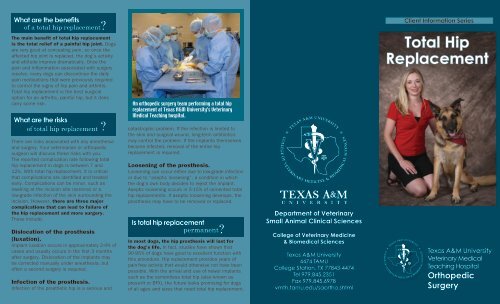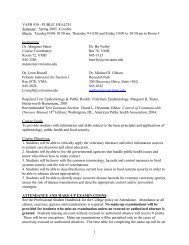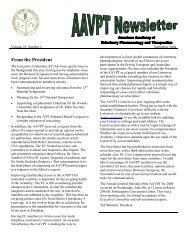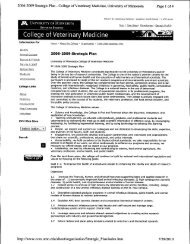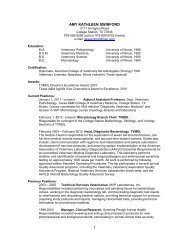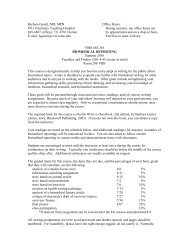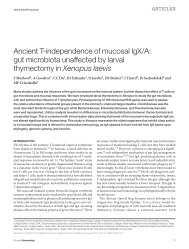Total Hip Replacement - College of Veterinary Medicine - Texas ...
Total Hip Replacement - College of Veterinary Medicine - Texas ...
Total Hip Replacement - College of Veterinary Medicine - Texas ...
You also want an ePaper? Increase the reach of your titles
YUMPU automatically turns print PDFs into web optimized ePapers that Google loves.
What are the benefits<br />
<strong>of</strong> a total hip replacement?<br />
The main benefit <strong>of</strong> total hip replacement<br />
is the total relief <strong>of</strong> a painful hip joint. Dogs<br />
are very good at concealing pain, so once the<br />
affected hip joint is replaced, the dog’s activity<br />
and attitude improve dramatically. Once the<br />
pain and inflammation associated with surgery<br />
resolve, many dogs can discontinue the daily<br />
pain medications that were previously required<br />
to control the signs <strong>of</strong> hip pain and arthritis.<br />
<strong>Total</strong> hip replacement is the best surgical<br />
option for an arthritic, painful hip, but it does<br />
carry some risk.<br />
What are the risks<br />
<strong>of</strong> total hip replacement ?<br />
There are risks associated with any anesthesia<br />
and surgery. Your veterinarian or orthopedic<br />
surgeon will discuss these risks with you.<br />
The reported complication rate following total<br />
hip replacement in dogs is between 7 and<br />
12%. With total hip replacement, it is critical<br />
that complications are identified and treated<br />
early. Complications can be minor, such as<br />
swelling at the incision site (seroma) or a<br />
low-grade infection <strong>of</strong> the skin surrounding the<br />
incision. However, there are three major<br />
complications that can lead to failure <strong>of</strong><br />
the hip replacement and more surgery.<br />
These include:<br />
Dislocation <strong>of</strong> the prosthesis<br />
(luxation).<br />
Implant luxation occurs in approximately 2-4% <strong>of</strong><br />
cases and usually occurs in the first 3 months<br />
after surgery. Dislocation <strong>of</strong> the implants may<br />
be corrected manually under anesthesia, but<br />
<strong>of</strong>ten a second surgery is required.<br />
Infection <strong>of</strong> the prosthesis.<br />
Infection <strong>of</strong> the prosthetic hip is a serious and<br />
An orthopedic surgery team performing a total hip<br />
replacement at <strong>Texas</strong> A&M University’s <strong>Veterinary</strong><br />
Medical Teaching hospital.<br />
catastrophic problem. If the infection is limited to<br />
the skin and surgical wound, long-term antibiotics<br />
may control the problem. If the implants themselves<br />
become infected, removal <strong>of</strong> the entire hip<br />
replacement is required.<br />
Loosening <strong>of</strong> the prosthesis.<br />
Loosening can occur either due to low-grade infection<br />
or due to “aseptic loosening”, a condition in which<br />
the dog’s own body decides to reject the implant.<br />
Aseptic loosening occurs in 5-15% <strong>of</strong> cemented total<br />
hip replacements. If aseptic loosening develops, the<br />
prosthesis may have to be removed or replaced.<br />
Is total hip replacement<br />
permanent?<br />
In most dogs, the hip prosthesis will last for<br />
the dog’s life. In fact, studies have shown that<br />
90-95% <strong>of</strong> dogs have good to excellent function with<br />
this procedure. <strong>Hip</strong> replacement provides years <strong>of</strong><br />
pain-free activity that would otherwise not have been<br />
possible. With the arrival and use <strong>of</strong> newer implants<br />
such as the cementless total hip (also known as<br />
press-fit or BFX), the future looks promising for dogs<br />
<strong>of</strong> all ages and sizes that need total hip replacement.<br />
Department <strong>of</strong> <strong>Veterinary</strong><br />
Small Animal Clinical Sciences<br />
<strong>College</strong> <strong>of</strong> <strong>Veterinary</strong> <strong>Medicine</strong><br />
& Biomedical Sciences<br />
<strong>Texas</strong> A&M University<br />
4474 TAMU<br />
<strong>College</strong> Station, TX 77843-4474<br />
Tel 979.845.2351<br />
Fax 979.845.6978<br />
vmth.tamu.edu/saortho.shtml<br />
Client Information Series<br />
<strong>Total</strong> <strong>Hip</strong><br />
<strong>Replacement</strong><br />
<strong>Texas</strong> A&M University<br />
<strong>Veterinary</strong> Medical<br />
Teaching Hospital<br />
Orthopedic<br />
Surgery
What is<br />
total hip replacement?<br />
A total hip replacement is a procedure in<br />
which the orthopedic surgeon replaces a painful<br />
or damaged hip joint with an artificial one. The<br />
hip joint is a “ball and socket” joint made <strong>of</strong><br />
two bones. These bones are partially removed<br />
and a metal and plastic artificial implant, or<br />
“prosthesis,” is placed to function like a<br />
normal hip. Removal <strong>of</strong> the affected hip joint<br />
eliminates the source <strong>of</strong> pain and lameness,<br />
thus allowing the patient to return to a normal<br />
level <strong>of</strong> activity. The new artificial hip provides<br />
a pain free joint substitute, and as such, limb<br />
function and activity level return to normal.<br />
Why is<br />
total hip replacement necessary?<br />
The most frequent indication for total hip<br />
replacement in dogs is the relief <strong>of</strong> pain<br />
and lameness caused by severe arthritis<br />
secondary to hip dysplasia, or fractures<br />
(breaks) and dislocation <strong>of</strong> the bones<br />
that make up the hip joint. Many dogs with<br />
arthritic and painful hips function fairly well with<br />
pain medication and exercise restriction, but<br />
when a painful joint is removed and replaced<br />
with a prosthesis, there is <strong>of</strong>ten a dramatic<br />
change in the patient’s activity, lameness,<br />
muscle mass, and personality.<br />
How do I know if my dog<br />
needs a total hip replacement?<br />
A complete physical, orthopedic, and<br />
neurologic examination will be performed<br />
by an orthopedic surgeon. A complete history<br />
<strong>of</strong> how and what your dog has been doing at<br />
home will be an important part <strong>of</strong> the decision<br />
making process. Common clues that a total hip<br />
replacement might be needed include hind limb<br />
lameness, reluctance to rise or jump, inability to<br />
exercise, pain after exercise, decreased activity,<br />
and loss <strong>of</strong> muscle mass.<br />
Radiographs (x-rays) <strong>of</strong> a dog with hip arthritis,<br />
secondary to hip dysplasia, before and after hip<br />
replacement.<br />
Are there reasons why my dog<br />
shouldn’t have a total hip replacement?<br />
Yes. If your dog suffers from skin, ear, dental, or<br />
urinary infections, or shows evidence <strong>of</strong> other<br />
potential sources <strong>of</strong> weakness or lameness,<br />
total hip replacement will not be performed. Other<br />
common causes <strong>of</strong> hind limb problems in dogs<br />
include rupture <strong>of</strong> the cranial cruciate ligament<br />
and neurologic problems such as intervertebral<br />
disk disease. Once these underlying problems are<br />
addressed and resolved, total hip replacement<br />
may again be considered. If a femoral head<br />
ostectomy (FHO) has already been performed, total<br />
hip replacement is extremely challenging and the<br />
chances <strong>of</strong> success are much lower. Finally, your<br />
dog must be finished growing (skeletally mature), so<br />
most dogs must be at least 10 months old before a<br />
hip replacement can be performed.<br />
How does the<br />
total hip replacement procedure work?<br />
Under general anesthesia, the surgeon removes the<br />
cartilage and bone that make up the hip joint. The<br />
diseased femoral head (the ball) is replaced with a<br />
metal prosthesis on a stem that fits inside the femur<br />
(thigh bone). The diseased part <strong>of</strong> the pelvis (socket)<br />
is replaced with a plastic or combination metal and<br />
plastic cup. The new prosthetic hip is designed to<br />
allow the joint to move in an identical manner to a<br />
normal hip. The prosthetic implants are very durable,<br />
and are anchored in place using either bone cement<br />
(cemented hip replacement) or by the dog’s own<br />
bone actually growing into the implants (cementless<br />
hip replacement). For more information on veterinary<br />
total hip implants, please visit www.biomedtrix.<br />
com.<br />
Biomedtrix cemented<br />
(CFX) total hip<br />
replacement implants.<br />
Long-term implant<br />
stability is achieved by<br />
placing bone cement<br />
inside the bones, then<br />
securing the implants<br />
into this bed <strong>of</strong> bone<br />
cement.<br />
Photo courtesy <strong>of</strong> Biomedtrix.<br />
Biomedtrix cementless<br />
(BFX) total hip<br />
replacement implants.<br />
Long-term implant<br />
stability is achieved as<br />
the patient’s bone grows<br />
into the porous portions<br />
<strong>of</strong> the implants.<br />
Photo courtesy <strong>of</strong> Biomedtrix.<br />
Should I stop all <strong>of</strong> my dog’s<br />
medications before surgery?<br />
Medications prescribed to treat systemic<br />
problems such as hypothyroidism should not<br />
be stopped. Medications for hip pain (aspirin<br />
or other non-steroidal anti-inflammatories,<br />
like Rimadyl®) should be stopped 3-5 days<br />
before the initial exam. If your dog is taking<br />
corticosteroids, or antibiotics, these<br />
medications should be stopped for a minimum<br />
<strong>of</strong> 2 weeks prior to surgery.<br />
Will surgery be performed<br />
the same day as the initial exam?<br />
No. Dogs undergoing evaluation for hip<br />
replacement must be carefully screened.<br />
A thorough physical exam, labwork (complete<br />
blood count, serum chemistry, urinalysis and<br />
urine culture), and specialized x-rays must<br />
be completed before surgery is considered.<br />
If problems are detected it might indicate<br />
that your dog is not a good candidate for<br />
the surgery. If the initial tests reveal no<br />
abnormalities, surgery is usually scheduled for<br />
1-2 days after the initial exam.<br />
What about my dog’s<br />
recovery and care after surgery?<br />
Most dogs can stand and walk on the<br />
new prosthesis the day after surgery<br />
and are able to go home after 3-5 days<br />
<strong>of</strong> total hospitalization. However, total hip<br />
replacement patients must be confined to a<br />
crate and allowed outside only on a leash to<br />
eliminate for 3 months after surgery. While at<br />
home, care should be taken to avoid walking<br />
on slippery surfaces, and long flights <strong>of</strong> stairs<br />
are not allowed. After the first 4 weeks <strong>of</strong> crate<br />
confinement, SLOW, 5 minute leash walks are<br />
started 2-3 times a day. These leash walks are<br />
increased by 5 minutes each week, until leash<br />
walks are 20 minutes long. These 20 minute<br />
leash walks are continued for 4 additional<br />
weeks, at which time the dog is returned to<br />
<strong>Texas</strong> A&M for re-examination and x-rays.


